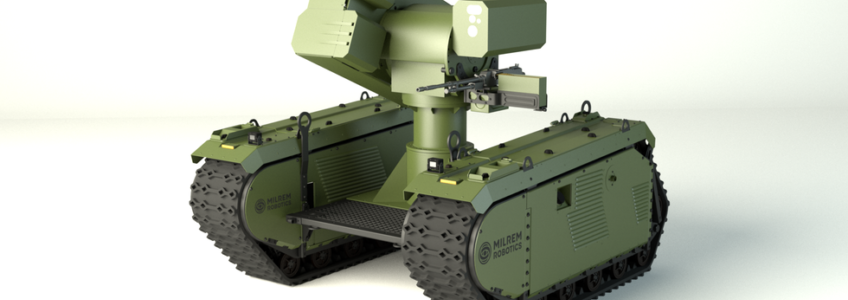While the implications of robotic military vehicles on human society are yet to be fully realised, the technology is here and probably have been for longer than we think. Most recently an Estonian defence firm, Milrem, launched the world’s first modular unmanned ground vehicles (UGV) doubling as a tank-destroyer. The modular, multi-purposed vehicle intends to provide support for dismounted troops in the shape of a transport platform, remote weapon station, IED detection and a UAV carrier among others.
The race to build the perfect military vehicle is an ongoing slog-fest and defence contractors around the globe have their hands full. More specifically, tank designers and anti-tank weapon designers are constantly pushing the envelope for better technology.
Manned versus Unmanned Ground Vehicles
For some time now, we’ve all seen the developments with autonomous civilian vehicles but what about for military applications? The battle between manned and unmanned military vehicles are stronger than ever and for good reason.
The recent introduction of ‘active protection systems’ on manned tanks appears to be the smoking gun. These systems use radar-directed projectiles to intercept incoming missiles which seemingly makes the manned tanks nearly invincible.
However, the rise of tank-killing drones or unmanned ground vehicles, shifts the balance of power once more. Robotic weapons are attractive because they are cheaper than manned weapons with zero risk of human casualties. Soldiers inside tanks are no longer as safe as they once were, primarily due to armies of inexpensive, deadly robotic vehicles.
One solution is to remove humans from attacking tanks altogether which, in itself, seems inevitable. Battlefields of the future could look entirely different with robotic vehicles fighting against robotic vehicles. Unmanned drones dropping bombs and firing hellfire missiles at UGV’s and other ground targets. Whether humans still control the battlefield pieces from a remote location or an artificial intelligence system remains to be seen. Modern warfare might very well be an industrial matter with little to no risk to humans.
Fact Sheet: THeMIS Unmanned Ground Vehicle
The Tracked Hybrid Modular Infantry System, also known as THeMIS, is the world’s first hybrid modular unmanned ground vehicle. The vehicle’s modular architecture offers multiple battlefield capabilities including scouting, fire support and cargo transport for ground troops.
THeMIS features a modular design, a hybrid diesel-electric drive complete with a “low or zero” noise signature. It can carry a payload of up to 1,650 pounds or around 750kg and can house a robotic arm or a .50 caliber machine gun.
If that isn’t frightening enough, THeMIS also has an even deadlier feature. Milrem partnered with European missile company, MBDA, and added the new Integrated MMP Precision Attack Combat Turret (IMPACT). This turret includes two MMP missiles (Missile Moyenne Portée, or Medium Range Missile).
The newest in unmanned ground vehicles combine a new deadly anti-tank missile with a robotic platform. As a result, this drone vehicle can destroy the most advanced tanks at a range up to 3.1 miles or 5 km. The MMP is one of latest anti-tank missiles and able to penetrate up to 39.3 inches (100 cm) of hardened steel armour plating.
In conclusion, these unmanned ground vehicles are more affordable, versatile and expendable compared to manned tanks. Because there are no operators within the vehicle, loss of life or debilitating injuries are zero to none. The modular architecture means one UGV could perform the task of multiple manned vehicles.
Applications For Milrem Unmanned Ground Vehicles
The robust and reliable UGV is incredibly stable with a low center of gravity. Its unique modular design allows for rapid reconfiguration and easily interchangeable superstructures. Among others, troop support to a communications relay and a RWS (multi-calibre weapons) platform. Other potential applications include:
- Medevac
- Articulated platform
- Demining
- UAV platform
- Anti-tank
- Fire fighting
- Recon or patrol
THeMIS is remote controlled with additional systems including ‘Follow operator’, ‘Autonomous control’ and ‘Swarm’. According to the Milrem website, a number of these systems are still in development but probably won’t be for long.
Depending on the type of superstructure, payload capacity may vary but the net weight is 1 450 kg (3 200 pounds). Top speed remains consistent at 14 km/h (8.6 mph) across all modules. Total length is 240 cm with a base height of 111 cm. The lead acid battery pack provides a run time of 30 minutes to 1,5 hours while the diesel-electric motor can go for 8-10 hours.
Warfare in terms of expendability and lethal force certainly is a conundrum but perhaps unmanned ground vehicles provide the answer. Is it all about to change? What additional value do you think these modular military vehicles could bring to the battlefield?
We’d love to hear your thoughts so please comment in the section below or find us on social media and remember to add #techviewPRV.
Please get in touch if you need assistance with your engineering or manufacturing project. PRV Engineering specialise in a number of industries including defence, construction, automotive, aerospace, rail and steel fabrication.


Recent Comments